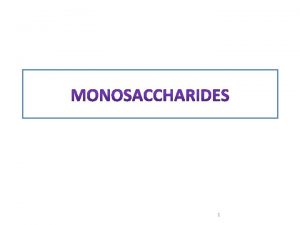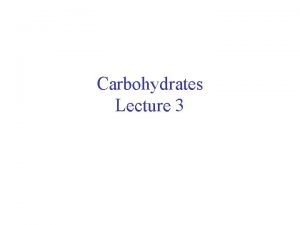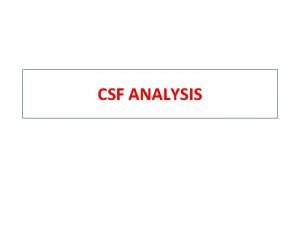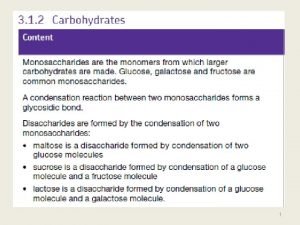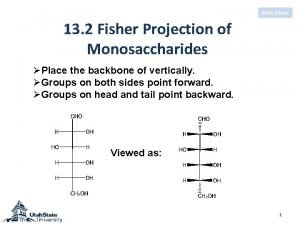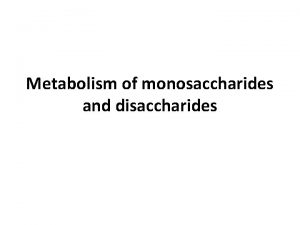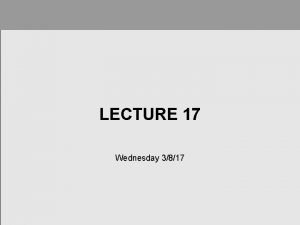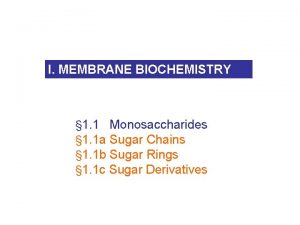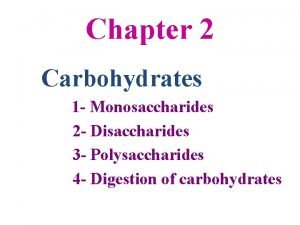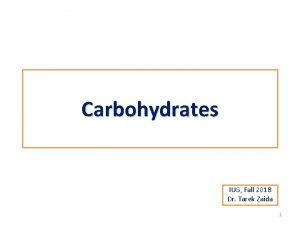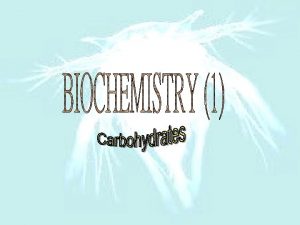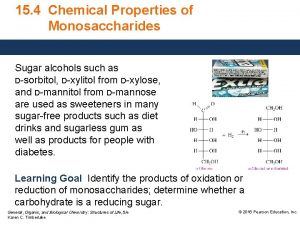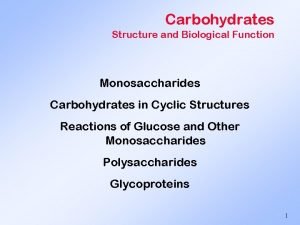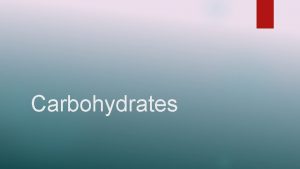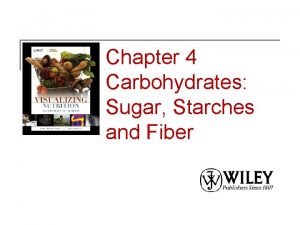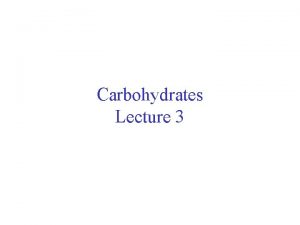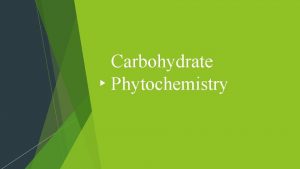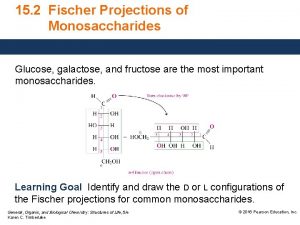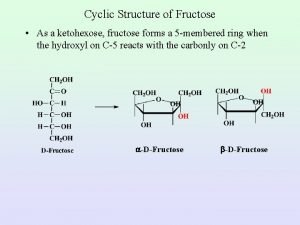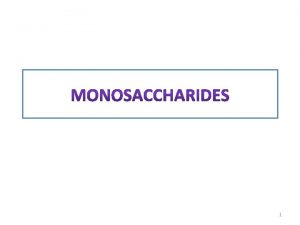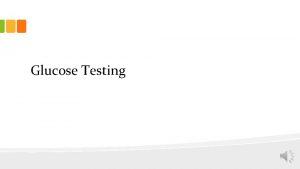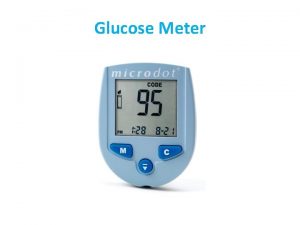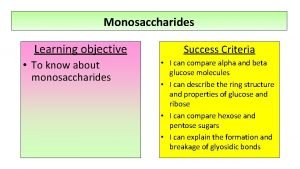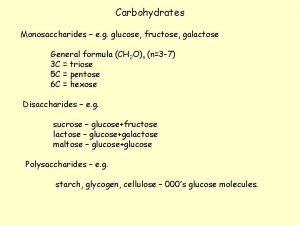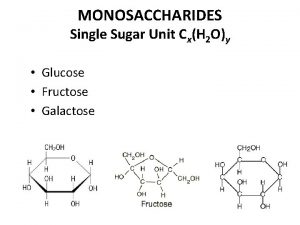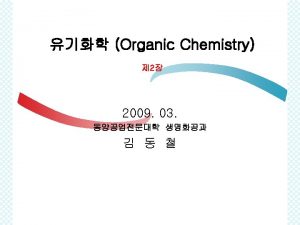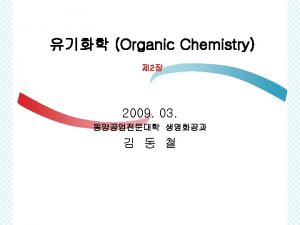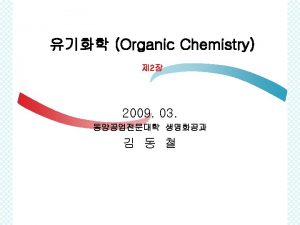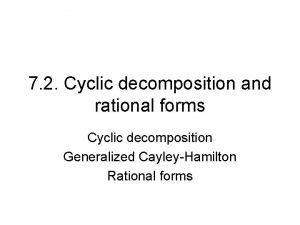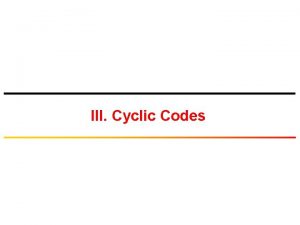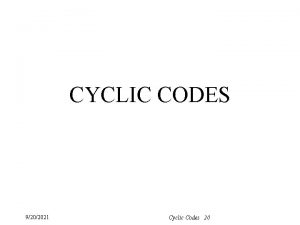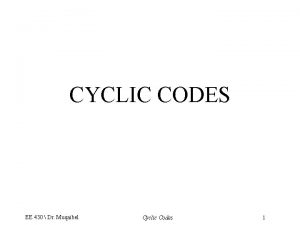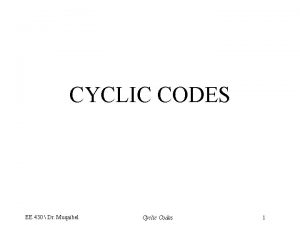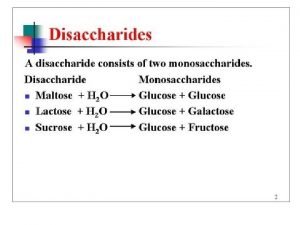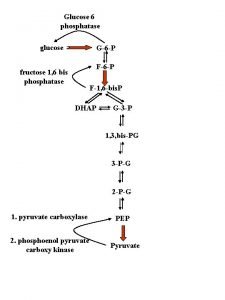1 Cyclic Form of Monosaccharides 1 Glucose 2
























- Slides: 24

1

Cyclic Form of Monosaccharides 1. Glucose 2

3

4

5

- 1. hydrolysis of sucrose 2. hydrolysis of starch Glucose is found in blood stream Found in tissue fluids If found in urine, it is an indicator of diabetes (glucosuria) Glucose may show up in urine during extreme excitement ( ) or after ingestion of a large amount of sugar ( ) 6

2. Galactose 7

• Glucose & Galactose are epimers. • Epimers: are 2 sugars that differ only in about a single carbon atom. D-galactose epimerase D-glucose Is a severe inherited disease results in the inability of infants to metabolize galactose because of a deficiency in either: 1. Galactose-1 -phosphate-uridyl transferase (GALT) 2. Galactokinase (GALK) As a result the galactose concentration will increase in blood and urine (galactosuria) 8

3. Fructose 9

• • Fructose is often called fruit sugar or levulose Can be prepared by hydrolysis of sucrose It also can be prepared by hydrolysis of Fructose is 1. 7 times sweeter than sucrose • An inherited disease (prevents the conversion of fructose to glucose) due to a deficiency of the enzyme fructose-1 -phosphate aldolase. As a result fructose will increase in blood. symptoms may include vomiting, hypoglycemia, severe malnutrition 10

11

Reactions of hexoses • Hexoses which are either aldoses or ketoses have reducing properties. • This reducing property of hexoses is the basis of the test for sugar in urine or blood. Gluconic acid 12

13

14

Reduction of Monosaccharides Note: Accumulation of sorbitol in the eye is a major factor in the formation of cataracts due to diabetes. 15

Fermentation • In the presence of yeast (or enzymes of yeast) glucose forms ethanol and carbon dioxide • Fructose can ferment but galactose can not. • Pentoses do not ferment in the presence of yeast. 16

Formation of Phosphate Esters • Glucose forms phosphate esters at carbons 1, 6 17

Amino Sugars • Amino sugars (hexosamines) contain an amino group on place of an –OH group. • Examples of natural amino sugars: • D- Glucosamine • D-galactosamine • D-mannosamine • Amino sugars are components of some antibiotics such as. D- Glucosamine • and 18

Amino Sugars • Amino sugars contain an -NH 2 group in place of an -OH group – only three amino sugars are common in nature: Dglucosamine, D-mannosamine, and D-galactosamine

Protein-Sugar Interactions • When the glucose level in the blood is elevated over a period of time, normal hemoglobin binds to glucose covalently. • The amount of glucosylated hemoglobin Hb. A 1 c in blood is used as a measure of the effectiveness of blood glucose control in a diabetic patient. • The concentration of Hb. A 1 c directly reflects the elevation of blood glucose over the preceding several days. 20

• In diabetic patient Hb. A 1 c is about 7 – 11% of the total hemoglobin (Hb. A) • In nondiabetic person this value ranges 4 – 6%. 21

The word epimer means each of two isomers with different configurations of atoms around one of several asymmetric carbon atoms present. In chemistry, epimers are diastereomers that differ in configuration of only one stereogenic centre. 22

The sugars α-glucose and β-glucose are epimers. In α-glucose, the -OH group on the second (anomeric) carbon is in the direction opposite the methylene group on carbon C-6 (in the axial position). In β-glucose, the -OH group is oriented in the same direction as the methylene group (in the equatorial position). α-D-glucose β-D-glucose 23

24
 Cyclic forms of monosaccharides
Cyclic forms of monosaccharides Carbohydrate aldehyde
Carbohydrate aldehyde Cerebrospinal fluid analysis
Cerebrospinal fluid analysis Maltose formation
Maltose formation Hexokinase method principle
Hexokinase method principle アルドヘキソース
アルドヘキソース Basic monosaccharides
Basic monosaccharides Monosaccharides disaccharides and polysaccharides
Monosaccharides disaccharides and polysaccharides Mannose galactose disaccharide
Mannose galactose disaccharide Chiral carbon in monosaccharides
Chiral carbon in monosaccharides Epimer vs anomer
Epimer vs anomer Are ketoses reducing sugars
Are ketoses reducing sugars Difference between monosaccharide and polysaccharide
Difference between monosaccharide and polysaccharide Chemical properties of monosaccharides
Chemical properties of monosaccharides Sugar chemical properties
Sugar chemical properties Cellobiose structure
Cellobiose structure Biomedical importance of monosaccharides
Biomedical importance of monosaccharides Complex carbohydrates are derived exclusively from plants
Complex carbohydrates are derived exclusively from plants Physical and chemical properties of monosaccharides
Physical and chemical properties of monosaccharides Identification test for tragacanth
Identification test for tragacanth D galactose fischer projection
D galactose fischer projection Ketohexose
Ketohexose Present continuous tense interrogative
Present continuous tense interrogative Cyclic pitch vs collective pitch
Cyclic pitch vs collective pitch Every item is priced separately
Every item is priced separately
